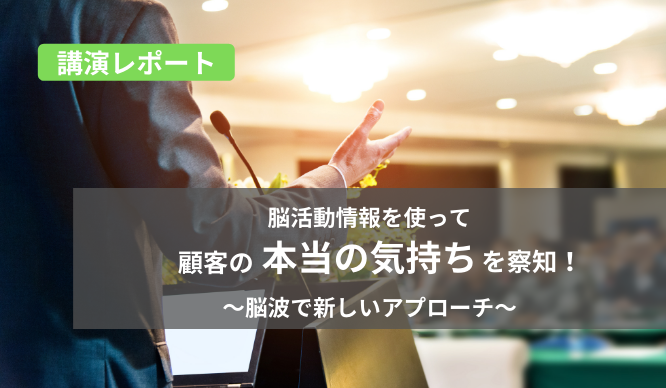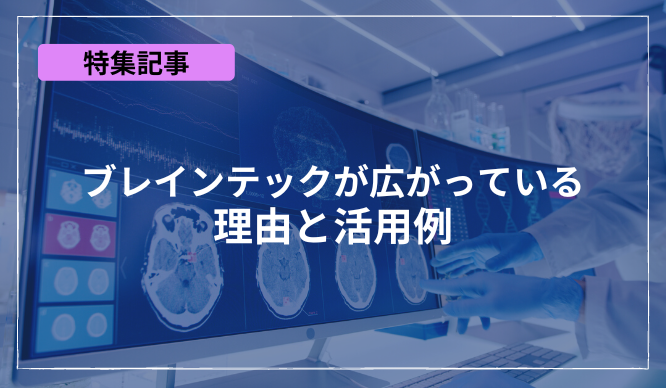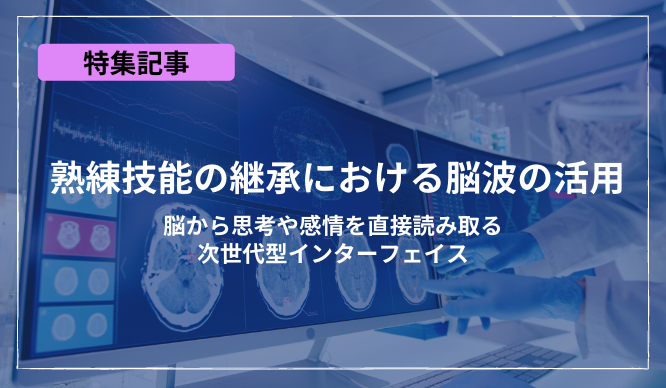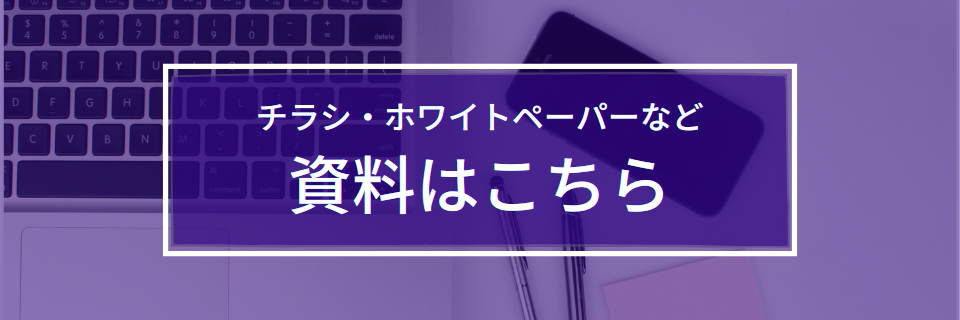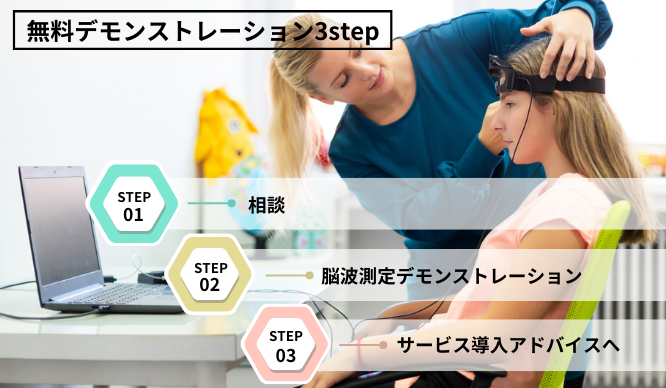Application for evaluation machine
New DX using brain science ~ How to use emotions and thoughts in business ~
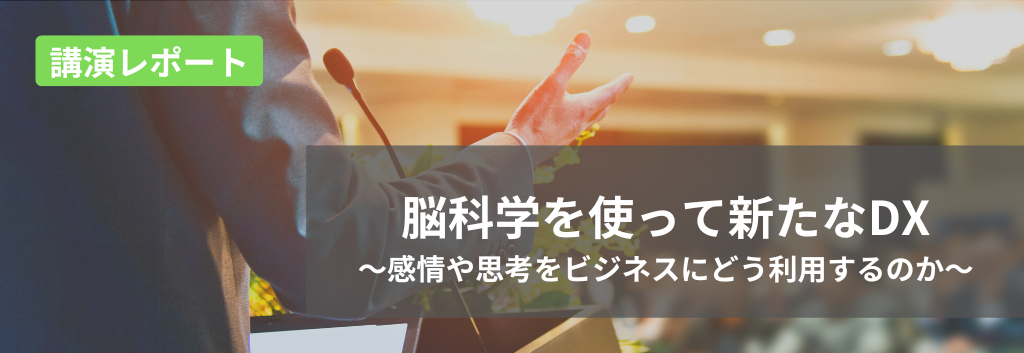
To make use of emotions and thoughts read from brain waves in business
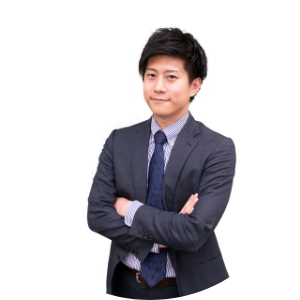
Takeshi Shimoyama, 2nd Promotion Consultant, 4th General Affairs Division
There is a growing trend to apply the results of neuroscience research to business. By reading brain responses with easily wearable devices and visualizing emotions and judgments, it is possible to solve problems that were previously difficult to solve.
In this article, Shimoyama of Macnica FINESSE Company introduces ways to utilize Brain Tech, such as modeling the tacit knowledge of experts and visualizing employees' concentration and interest levels to assign personnel to the right positions.
We have also introduced it in a video. If you are interested, please watch it.
Watch the video here
Challenges facing companies in "explicitizing tacit knowledge" and "retaining talent"
Many companies face challenges related to human resources when it comes to continuing their business. Shimoyama explains two typical challenges as follows:
"The baby boomer generation is approaching retirement age, but the transfer of skills from skilled workers is not progressing as expected. To grow a company in the long term, it is important to teach the younger generation through planned on-the-job training, and to do this, skilled workers must be made into explicit knowledge.
In recent years, which are said to be an era of rapid job changes, talented personnel are easily lost. Another issue is that the common sense of working is different from that of the past, which makes young people sick and makes it difficult for personnel to stay in the company. It is necessary to take measures to maintain high productivity while promoting retention by placing employees in appropriate job types and facilitating communication within the company." (Shimoyama)
The growing use of "brain data" in the business world
"Brain Tech" is a new approach to solving the human resources issues mentioned above. Today, brain science has gone beyond the realm of research and medicine, and brain tech is being applied to the business world. For example, Neuralink, led by Tesla founder Elon Musk, is developing neural chips to be implanted in the brain. At a promotional event for a new pizza product, an American fast food chain created a game content that used brainwaves as an interface, allowing users to cut pizza by the strength of their thoughts, which became a hot topic.
"Recently, the wave of brain tech has been sweeping Japan as well. For example, one Japanese tire manufacturer is using brain data to prove that its tires reduce stress levels while driving, and is promoting them as 'tires that reduce fatigue.' Brain tech is also starting to be used in sensory tests during product development and in research into autonomous driving cars." (Shimoyama)
Key measures of brain data
So how do we measure brain data? "There are five main technologies for measuring the brain, and of these, NIRS and EEG seem to be the two most commonly used in business. With EEG, a device is worn to capture the frequency of electrical signals emitted from the cerebral cortex," Shimoyama explains.
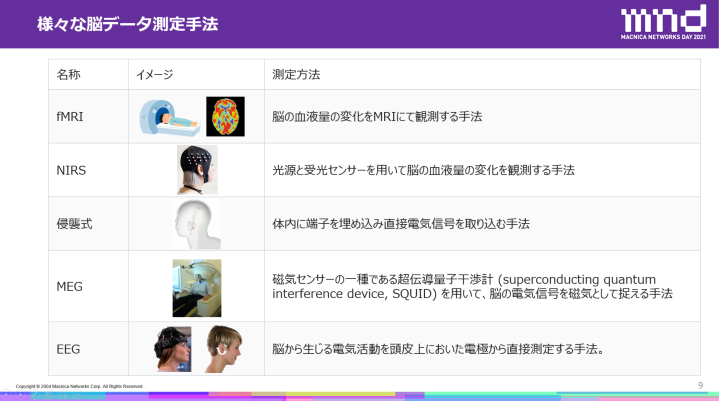
"Brainwaves are generally expressed in frequency, and when we are at rest, we emit alpha waves in the 10 Hz range. When we are excited, they become high-frequency waves called beta waves, and when we are in a light sleep state, they become low-frequency waves like theta waves. Using these characteristics, we can measure the level of concentration, interest, and reactions to visual and auditory information." (Shimoyama)
Utilizing brainwaves to formalize tacit knowledge
So how can brainwaves be used to help transfer the skills of experts? Tacit knowledge is often a mixture of judgment and work, and in some cases it is simply not well put into words.
"It is said that about 90% of tacit knowledge is reproducible. If you look at the content of a job, 50% is selective judgment and can be patterned to a certain extent. 40% is work or technique, and can be reproduced by someone else if they learn how to do it. And the last 10% is true tacit knowledge, and is said to be judgment based on the individual's values." (Shimoyama)
To formalize tacit knowledge, first break down the "tasks that only you can do" into as many factors as possible. They are probably made up of a combination of judgment and work. Then, think about which of the various elements is the biggest bottleneck, and which improvement would have the greatest impact on management.
"For example, inspection processes that are carried out by the eyes of craftsmen have disadvantages, not only in terms of cost, but also in that the workload of the person in charge can become heavy and it is difficult to accommodate sudden increases in production or expansion of the line. Even if orders increase, the productivity of the inspection process cannot be increased to accommodate them, which creates a major bottleneck for the profit structure of the entire company. If we could model this and automate it using AI, it would completely change the company's profit structure." (Shimoyama)
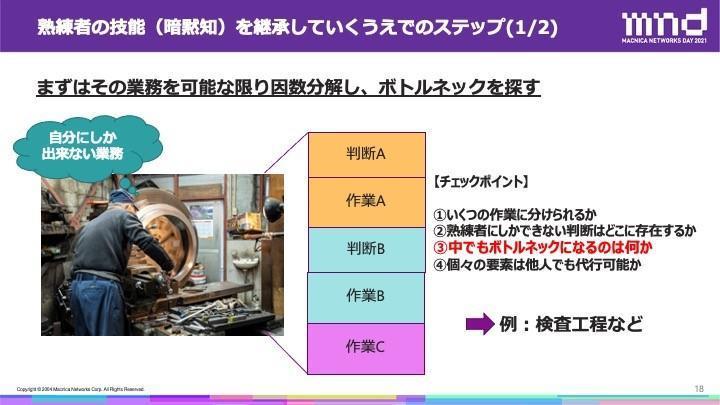
Identifying bottlenecks in tacit knowledge, modeling it, and automating it with AI will dramatically change a company's profit structure.
Once the bottleneck has been identified, the next step is to model that task. There are several methods for making tacit knowledge explicit, including image analysis, natural language analysis, acoustic and vibration analysis, and brainwave analysis, so we consider the most suitable method for the subject.
"When using an EEG device to analyze brainwaves, we make sure that it is attached correctly in order to capture weak electrical signals. Brainwaves vary from person to person, so we obtain normal brainwaves as a reference point and then determine the individual's distinctive features." (Shimoyama)
From this point on, we will use brainwaves to generate an AI learning model. In the case of an inspection process performed by an expert, the recognition of whether visual information is normal or abnormal is determined by brainwaves, and the brainwaves recorded when an abnormality is detected are combined with the image data at that time to allow the AI to learn the model.
Shimoyama says that the accuracy has also reached a practical level. For example, in a demonstration experiment of an AI model to detect defects in screws, it was possible to build an AI model with higher accuracy than conventional methods. In this case, the amount of training data required was smaller than with conventional image recognition methods. In addition, labeling the photos to assign meanings did not require mouse or keyboard operation, and the work could be completed in an extremely short time.
"This is the power of image recognition AI using brainwaves. Since it only looks at brainwaves, it can't tell you the condition or location of the wound, but this can be remedied by combining it with eye tracking and other technologies." (Shimoyama)
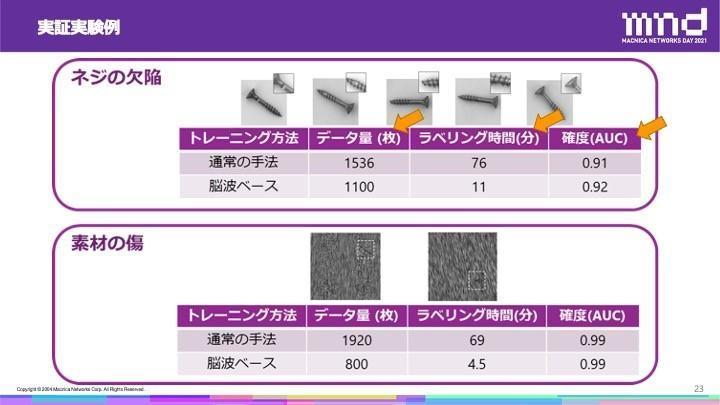
脳波を活用すれば、通常の手法と同程度以上の精度を少ない負担で実現できます
脳波を活用して人材の定着化と最適な職種配置を実現
Brain Intech is also effective in identifying the actual situation regarding employee turnover and lack of retention, as well as appropriate job placement. Generally, the reasons for changing jobs seem to be worries about interpersonal relationships and work content, but if psychological states can be quantified, optimal job placement can be carried out and employee turnover can be prevented.
"We are currently working with a human resources company on a research initiative to identify employee aptitudes. We analyze a person's level of concentration, interest, and fatigue while working, and then analyze the type of work that suits them, when to take breaks, and the type of boss they should work under." (Shimoyama)
Macnica is currently developing a product that visualizes emotions in real time. Using a small device, we are visualizing how interested a person is in an advertisement they see while driving, the level of danger they feel, and their level of concentration. This can be applied to the human resources industry as well as to determining near-miss situations in the logistics and construction industries, and to judging consumer interest in the marketing industry.
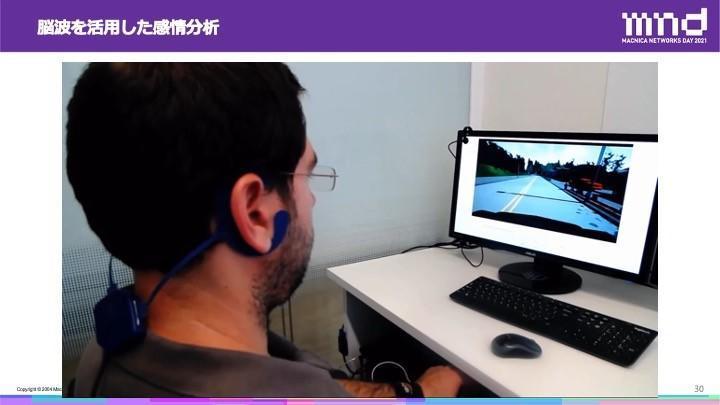
We are currently developing a product that can visualize and analyze emotions in real time using a small device.
Finally, Shimoyama said, "In addition to the use cases we have introduced, we receive various other inquiries. Brain Tech can handle not only visual information but also auditory information. If you are interested, please feel free to contact us."
movie
This content is also introduced in the video. If you are interested, please apply below.
Related information
List of articles
List of articles
If you are interested in other Braintech-related articles, please click here.
Document download
If you want to know the details, please download the materials from here.
free demonstration
Guidance of the demonstration
Would you like to actually measure brain waves?
What is the "skill transfer of experts" based on brain waves? What is AI that learns human consciousness and judgment?
I think there are a lot of unknown things, so why not try measuring your brain waves first and experience what it's like?
After the actual measurement, we will provide support from proposals to implementation and operation so that we can use AI using EEG at the customer's site while including examples of AI utilization in our activities so far. increase.
Learnmore
Inquiry
If you have any questions regarding this article, please contact us below.
